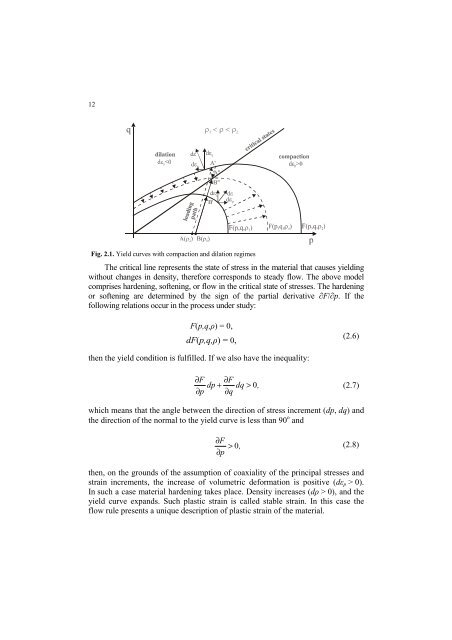Strona 2_redak - Instytut Agrofizyki im. Bohdana DobrzaÅskiego ...
Strona 2_redak - Instytut Agrofizyki im. Bohdana DobrzaÅskiego ...
Strona 2_redak - Instytut Agrofizyki im. Bohdana DobrzaÅskiego ...
Create successful ePaper yourself
Turn your PDF publications into a flip-book with our unique Google optimized e-Paper software.
12<br />
Fig. 2.1. Yield curves with compaction and dilation reg<strong>im</strong>es<br />
The critical line represents the state of stress in the material that causes yielding<br />
without changes in density, therefore corresponds to steady flow. The above model<br />
comprises hardening, softening, or flow in the critical state of stresses. The hardening<br />
or softening are determined by the sign of the partial derivative ∂F/∂p. If the<br />
following relations occur in the process under study:<br />
F(p,q,ρ) = 0,<br />
dF(p,q,ρ) = 0,<br />
(2.6)<br />
then the yield condition is fulfilled. If we also have the inequality:<br />
∂F<br />
∂F<br />
dp + dq > 0,<br />
∂p<br />
∂q<br />
(2.7)<br />
which means that the angle between the direction of stress increment (dp, dq) and<br />
the direction of the normal to the yield curve is less than 90 o and<br />
∂F<br />
> 0 ,<br />
∂p<br />
(2.8)<br />
then, on the grounds of the assumption of coaxiality of the principal stresses and<br />
strain increments, the increase of volumetric deformation is positive (dε p > 0).<br />
In such a case material hardening takes place. Density increases (dρ > 0), and the<br />
yield curve expands. Such plastic strain is called stable strain. In this case the<br />
flow rule presents a unique description of plastic strain of the material.
















